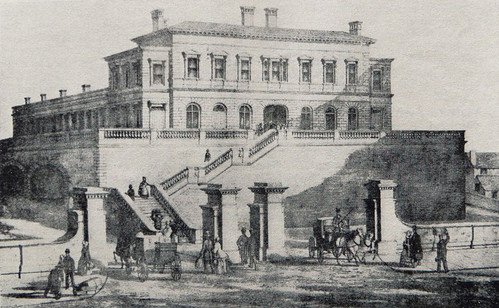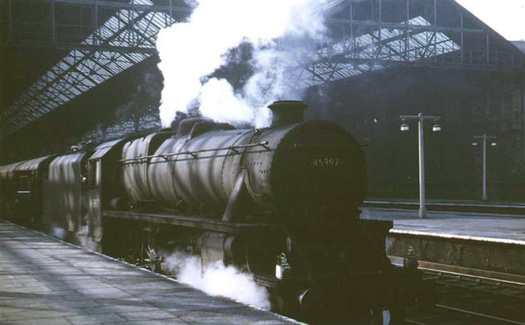Liverpool Exchange was once one of the city’s most important railway terminals, serving the northern destinations of the Lancashire and Yorkshire Railway (LYR). It opened on 13 May 1850, originally known simply as “Exchange Station,” to replace the temporary Great Howard Street terminus. Located in the heart of Liverpool’s business district, it quickly became a key part of the city’s transportation infrastructure, handling both passenger and goods traffic.
The station was notable for its ornate frontage and large trainshed. The frontage, designed in the Italianate style, was built with an eye to grandeur, featuring stone columns, an impressive clock tower, and an imposing presence along Tithebarn Street. Behind this elegant face was the station’s real heart: a wide, high-arched iron and glass trainshed that covered multiple platforms. The structure was typical of mid-19th century railway architecture, marrying aesthetic considerations with practical engineering.

How Liverpool Exchange looked at the time it opened in 1850
Initially, the station handled traffic between Liverpool and important industrial towns such as Manchester, Bolton, and Preston. As the Lancashire and Yorkshire Railway expanded its network, Liverpool Exchange became the terminus for services from all over the northwest of England and even parts of Yorkshire. In the early 20th century, it was handling more than 200 trains per day, making it one of the busiest stations outside London.
In 1906, the station was expanded. This expansion was necessary to accommodate the increasing volume of traffic and involved adding two new platforms, bringing the total to nine. The expansion also included a reworking of the approach tracks, which came into the station in a wide fan formation under a complex series of signal gantries. The signalling at Liverpool Exchange was itself noteworthy, utilising some of the earliest electric signal interlocking systems, a major innovation at the time that helped to manage the heavy train movements in and out of the station.
Liverpool Exchange was particularly important for commuter traffic. Long before the concept of modern suburban rail, Exchange was handling vast numbers of workers commuting daily from places like Southport, Ormskirk, and Wigan. These services were operated by steam trains initially but were electrified from 1904 onwards, making the Liverpool to Southport line one of the earliest examples of mainline electrification in the world. The Liverpool to Southport service used a 630 V DC third-rail system, a standard that would later be adopted by many suburban networks across the UK.
The station suffered significant damage during the Liverpool Blitz of 1940–41. Incendiary bombs destroyed much of the trainshed roof, leaving only a skeletal framework above the platforms. Despite this, the station remained operational throughout the war, a testament to both the resilience of the railway workers and the critical importance of maintaining transportation links during wartime.
After the war, Liverpool Exchange entered a long period of slow decline. The post-war years saw major changes in travel habits, with road transport beginning to overtake railways in popularity. In addition, government policy increasingly prioritised road over rail. The Beeching Report of the early 1960s spared Liverpool Exchange itself, but it did lead to the closure of many of the lines feeding into it, particularly the cross-country routes to East Lancashire and Yorkshire.

Train departing the station in 1968, note the structure of the roof
The final blow came in the 1970s with the development of the Merseyrail network. The idea was to streamline Liverpool’s heavy rail system into an electrified urban network. Liverpool Exchange’s long approach lines, which ran at surface level through densely populated areas, were seen as a problem. It was decided to replace the surface lines with underground tunnels leading to a new city centre station: Moorfields.
Liverpool Exchange closed its doors to passengers on 30 April 1977. The final departure was the 23:30 service to Ormskirk. Services were transferred to Moorfields the following day, which had been specially built to integrate with the new Link Line tunnel between the Northern and Wirral Lines.
Following its closure, the trainshed was demolished, but the main station frontage was retained and incorporated into a new office development called Mercury Court. If you visit today, you can still see the old station façade, complete with its stonework and clock, standing proudly among modern buildings. It is one of the few remaining physical reminders of a once bustling hub of Liverpool’s railways.
An interesting technical footnote: the old electrification system from Exchange to Southport remained largely in place even after the closure, simply being diverted through the new underground tunnels. Thus, when travelling on Merseyrail’s Northern Line today, passengers are in a sense still following the electrified route established more than a century ago for services into Liverpool Exchange.
Another piece of trivia: in its heyday, Liverpool Exchange was so busy that special “parliamentary trains” (low-cost services required by law) operated very late at night or very early in the morning to avoid clogging the already packed daytime timetable. One such service left Exchange at 4:00 AM and made a slow, stopping journey all the way to Manchester Victoria, picking up night workers and early risers along the way.
Liverpool Exchange may be gone as a functioning railway terminal, but it remains an essential chapter in Liverpool’s railway history, representing an era when the city’s prosperity and the energy of the Industrial Revolution were channelled through the bustling platforms under that great iron and glass roof.
